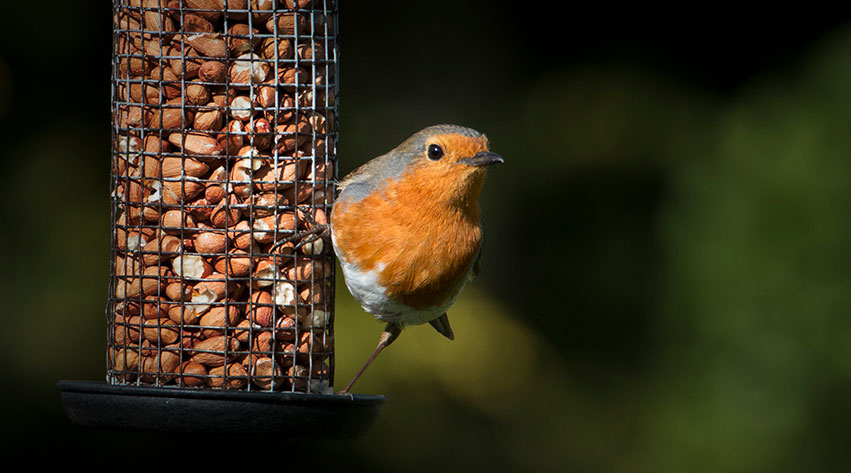
How to attract birds to your garden
Birds add interest, movement and sound to our gardens as well as helping to keep down certain insect pests – especially many caterpillars and aphids. Our feathered friends welcome food throughout the year; in colder months when food is in short supply, to help them when nesting and raising chicks in spring and also through the summer months when the weather can be very dry. Our guide reveals how to attract birds to your garden with a few simple tips as well as advice on the food they need (and can’t eat) to get through the seasons.
Getting started
- Decide where you will site your feeders. An open position is best, so that the birds can spot danger from predators including cats and birds of prey, such as Sparrow Hawks. Make sure there is cover nearby in case the birds have to take refuge quickly.
- Site the feeders where they can be seen from the house – this is a great way to get children interested in bird watching.
- For shyer species, you may wish to site a feeder in a quieter part of the garden.
Visit your local Garden Centre and choose from the huge range of feeders and bird tables available.
- It is a good idea to half fill your feeder to start with, especially if the weather is wet. Birds will usually find feeders within a couple of days but some foods can go soggy quickly and will be wasted. You will soon get to know how quickly the feeder is emptied and can top it up more regularly.
- Find a cool, dry place to store your bird food and be sure to keep all food in metal or plastic containers to deter mice and rats.
Food that birds can be fed
Autumn is a time of ‘berried’ treasure in the garden and many gardeners look on with mixed feelings as members of the Thrush family feast on the lush red and orange fruits of Pyracantha, Cotoneaster and Sorbus (Rowan) trees, amongst many others. Holly berries are another favourite and trees are often stripped well before they are needed to decorate our houses for the festive season.
Insect cakes and mealworms are also a good source of natural food and are stocked at your local Garden Centre. Suet balls and suet cake are great for birds and there are special feeders available for this kind of food. Avoid hanging these up in nets or on string as birds can get caught in them. It’s incredibly easy to make your own suet mix - simply pour melted suet or lard over a mix of seeds, nuts, cake and cheese and leave to set. This can then be turned onto the bird table or set in an empty coconut shell and hung up for Tits to enjoy.
Cake, uncooked fruit and cheese are all ideal extras from the kitchen. Using a variety of different foods will attract a wider range of birds, especially during the winter when food is scarce.
Fatty foods, like suet balls and cakes, are great for birds in the winter, but avoid feeding them these foods in the summer. Birds require high protein foods in the summer, especially while they are moulting. Try black sunflower seeds, pinhead oatmeal, soaked sultanas, raisins and currants, mild grated cheese, mealworms, waxworks and summer seed mixture while the weather is warmer.
Top tip:
Don’t put too much food on the ground at one time. This may attract rats and other vermin. Remove any excess that is spilt from feeders as well.
More ways to help attract birds to the garden
Do not be too quick to deadhead your plants - you will be surprised at the number of birds that will feast on the seeds. Plants such as Teasels make an upright, architectural statement with their spiky leaves and large heads of blue green flowers. The seeds are irresistible to many finches including the brightly coloured Gold Finches with their chattering call both in flight and as they perch to feed. Many of the Cranesbills (hardy Geraniums) have seeds that are attractive to birds as do Verbena Bonariensis and many ornamental grasses. Why not plant some Sunflower seeds next spring and leave some of the spent heads for the birds – they will love you for it! Overwintered plant material such as dried heads of grasses will be used as welcome nesting material by many birds in spring when the cycle begins again.
Nest boxes can be put up in early spring as the birds begin to pair up – traditionally by Valentine’s Day– and start to look for a nest site. Different nest boxes suit different bird species, so make sure that you do some research or ask advice. Blue Tits like to nest in an enclosed box with an entry hole in the front whereas Robins like to nest in an open fronted box. You can even buy nest boxes for woodpeckers, which need to be sited high on a tree trunk.
It’s a good idea to make sure there is always clean water available for bathing and drinking too.
Don’t stop feeding the birds once you start. They will come to depend on you through hard weather and will use vital energy flying to your garden to feed.
We can all do a little bit to help our feathered friends, who in turn will help to keep pests such as caterpillars and aphids down in our gardens, as well as adding interest and theatre to our outdoor spaces.


